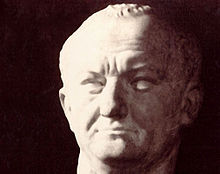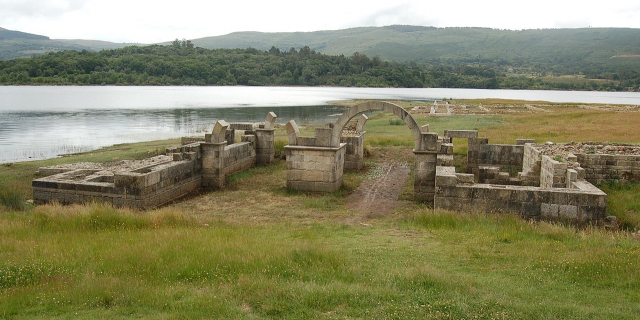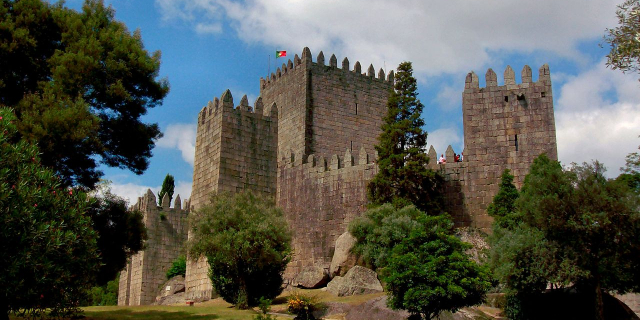Chaves (Portuguese pronunciation: [ˈʃavɨʃ] ) is a city and a municipality in the north of Portugal. It is 10 km south of the Spanish border and 22 km south of Verín (Spain). The population of the entire municipality in 2011 was 41,243, in an area of 591.23 km2. The municipality is the second most populous of the district of Vila Real (the district capital, Vila Real, is 60 km south on the A24 motorway). With origins in the Roman civitas Aquæ Flaviæ, Chaves has developed into a regional center. The urban area or city proper has 17,535 residents (2001).
 Titus Flavius Caesar Vespasianus Augustus, patron of Aquae Flaviae
Titus Flavius Caesar Vespasianus Augustus, patron of Aquae Flaviae Remnants of the ancient keep of the Castle of Chaves
Remnants of the ancient keep of the Castle of Chaves Roman bridge of Emperor Trajan crossing the Tâmega river
Roman bridge of Emperor Trajan crossing the Tâmega river Cannon near the castle
Cannon near the castleArtefacts discovered in the region of Chaves identify the earliest settlement of humans dating back to the Paleolithic.[1] Remnants discovered in Mairos, Pastoria and São Lourenço, those associated with transient proto-historic settlements and castros, show a human presence in the Alto Tâmega dating to the Chalcolithic.[1] The region has seen persistent human settlement since Roman legions conquered and occupied the fertile valley of the Tâmega River, constructing a nascent outpost and taking over the existing castros in the area. The settlement was located at the convergence of three important Roman roads: the Bracara Augusta, Asturica, and Lamecum that crossed the Roman Province of Gallaecia, linking Rome to the region's natural resources.[1] It was a military centre known for its baths, which lasted until the 16th century. This civilization constructed protective walls to protect the local population; spanned the river with the bridge;[2] promoted the baths (with its warm medicinal waters); exploited local mines and alluvial deposits and other natural resources. Its importance led to the urban nucleus being elevated to the status of municipality in 79 AD, during the reign of the first Flavian Caesar, Titus Flavius Caesar Vespasianus Augustus.[1] Its benefactor consequently influenced its toponymy, becoming known as Aquae Flaviae. Artefacts from the area around the Matriz church indicate that Aquae Flaviae's centre was located in this place, in addition to an ancient headstone showing gladiatorial combat.[1][3]
Rome's hegemony lasted until the 3rd century, when, successively, the proto-Germanic tribes of the Suebi and Visigoths as well as the Alani colonized the imperial settlements of Chaves.[1] Wars between Remismund and Frumar followed over their claims to the throne, which almost completely destroyed the village (it was settled in favour of Frumar, who imprisoned Idácio, the notable Bishop of Aquae Flaviae).[1] Ironically, the Romans were complicit in Aquae Flaviae's near destruction.[4] Barbarian dominion lasted until the Moors invaded from North Africa, defeating the Visigoth King Roderic at the beginning of the 8th century.[1]
In course, the name of Aquae Flaviae began to disappear, being supplanted by the more Hispanic-sounding Aquae Calidae (English: hot waters).[5]
The area around Chaves surrendered to invading Islamic forces at around 714-716, forcing many resisting Christians to escape from Chaves into the mountains in the northwest. The city was conquered by Alfonso I of Asturias in 773,[6] alongside Braga, Porto and Lamego, and repopulated in 868 by Alfonso III of Asturias.[7] Battles between the Christians and Muslim forces then continued until the 11th century, when Alfonso V of León permanently reconquered Coimbra, establishing a firm buffer-zone to the south.[1] He reconstructed, settled and encircled the settlement of Chaves with walls, in addition to establishing a Jewish quarter in the community. It was in the reign of Afonso I of Portugal that it was taken from León and firmly integrated into the Kingdom of Portugal domain (1160).[1] Owing to its geographic location (on Portugal's northern frontier with Spain), King Denis, ordered the construction of a castle to protect the kingdom's border.[1]
During the reign of Afonso II, when the king continued to provoke the ire of the Papacy, Portuguese knights attacked the Galician tenancy of his half-brother Martin Sanches (who lived in the kingdom of Alfonso IX of León), possibly since the Bishop of Braga had estates in that region. Provoking Sanches to invade northern Portugal.[8] The Leonese fought battles in Barcelos, Braga and Guimarães, where they defeated Portuguese forces, before retiring to Galicia with their spoils.[8] At the same time, Alfonso IX of León seized Chaves, which remained in Leonese hands until the reign of King Sancho II, when he and Ferdinand III met in 1230/1231.[8][9] This was likely a self-serving decision on Fernando's part, as he was fearful that Leonese barons would support Sancho against him. Alfonso IX continued to occupy Chaves as a method of ensuring his wife, Teresa, would be able to enjoy her properties in Portugal.[9]
During the Portuguese Interregnum, the nobility of Chaves supported Beatrice of Portugal, as she was heir presumptive to King Ferdinand I, since he left no male heirs. The potential loss of independence of Portugal, through her marriage to John I of Castile resulted in the rebellion by the Master of the Order of Aviz (later King John I of Portugal), who would garner the support of the Portuguese Cortes, thus laying the seeds for his triumph at the Battle of Aljubarrota.[10] Yet, many nobles refused to break their oaths of fealty to Beatrice (including in Chaves), necessitating John's travel to Porto in force and scaring the nobles of Chaves and Bragança into capitulating.[10]
The remnants of the Roman baths, and the houses used to assist the invalid, were demolished by the Count of Mesquitella at the end of the 17th century, in order to reinforce the defense of Chaves.[11]
French forces invaded and attacked in 1807, during the Siege of Chaves, part of the Peninsular Wars.[12] On 7 March 1808, Soult's forces invaded northern Portugal to remove British forces from Iberia. Brigadier Francisco Silveira was charged with the defense of Chaves, but his 6000 men were unable to support its defense, and quickly abandoned the castle.[13] An attempt to defend Chaves by Francisco Pizarro was futile, and the city surrendered to French forces shortly after the engagement. With too many troops to imprison Soult released many under oath, in order to continue the attack on the main forces who had retreated to the south.[13] But Francisco Silveira did not quit, and as the main French went on to defeat the Anglo-Portuguese alliance at the First Battle of Porto, Silveira retook Chaves.
On 20 September 1837, the Convention of Chaves, which followed the Battle of Ruivães and which ended Chartist or Marshall's Revolt, was signed in Chaves.[1] Chaves was also a site of various religious apparitions, during the decade of 1830, eventually resulting in the construction of the Santuário da Nossa Senhora Aparecida (Portuguese: Sanctuary of Our Lady Revealed).[1]
On 8 July 1912, forces loyal to the former monarchy, under the command of Henrique Paiva Couceiro, confronted government forces, commanded by Colonel Ribeiro de Carvalho, during the second monarchist incursion.[1][14][15]
On 12 March 1929, the town of Chaves was elevated to the category of city.[1]































Add new comment